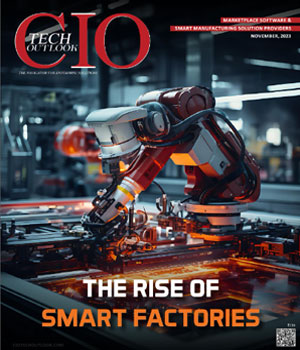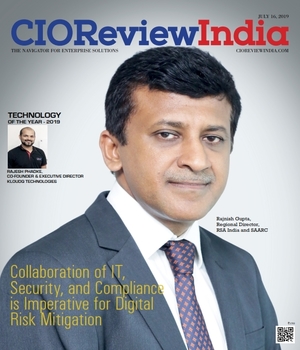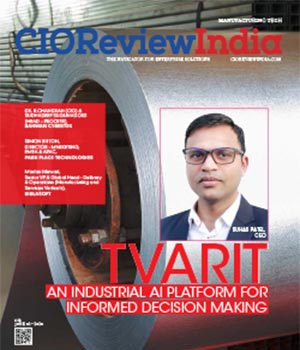
Machine Learning Revolutionizing Manufacturing
Tanushree Bagrodia, Chief Financial Officer & VP - IT, NRB Bearings Limited | Monday, 17 September 2018, 11:44 IST
 In today’s volatile, uncertain, complex and ambiguous (VUCA) world, an agile and cost-effective manufacturer needs to cater to market demand timely and with quality products. This creates the need for manufacturing systems to be pull and precision-driven.
In today’s volatile, uncertain, complex and ambiguous (VUCA) world, an agile and cost-effective manufacturer needs to cater to market demand timely and with quality products. This creates the need for manufacturing systems to be pull and precision-driven.
Historically manufacturing has been rooted in observing past data, analysing the same, deciding how to improve and then acting on the conclusions. Machine learning not only allows observation of historical data, but forecasts demand, analyses past and future in tandem to take decisions that will pre-empt glitches, and ultimately enables businesses to be proactive (over-reactive), cost-effective (over cost controlling) and lean.
Machine learning is iterative, causing algorithms to learn with each repetition and optimise actions to be taken. Deep learning, a further refinement of machine learning, is based on pattern recognition. It allows algorithms to identify outcomes by superimposing past patterns on a new real-time one.
Being measurable, machine learning can easily be used to change old processes and execution design. World leaders such as Siemens and GE are investing billions of dollars to transform their manufacturing setups. It is not long before that even smaller firms will follow suit.
This article discusses the vision and challenges for adopting machine learning in core manufacturing and supply chain processes. Machine learning for product design deserves standalone attention.
Organisation Vision for Adopting Machine Learning
Enhance Supply Chain
• Forecast Demand &analyse past
customer purchases
• Control inventory levels
• Optimise time to market
Improve Production Efficiency
• Govern quality levels& reduce
wastage
• Optimise batch sequencing
• Optimise MRO times
Enhance Competitiveness
• Identify underserved markets & competitive advantages
• Enhance product pricing in real time
• Create leaner decision making
Machine learning can be effectively used to optimise supply chain with accuracy and precision like never seen before. Modeling different customer requirements and purchase patterns, the need for a product can be understood; consequently, calculating raw material requirement. Extrapolating future requirements allows smoother supplier-buyer interactions and WIP (work in progress) build up. Maintaining inventory at optimal levels ensures that lack of material does not create a loss of sales. This can be vital if material procurement has a long lead cycle or the just the availability of the right WIP can reduce assembly times. With the iterative and forecasting ability of machine learning, not only will working capital management be simpler, but more importantly supply chain processes will become transparent.
“The future of manufacturing with machine learning, capabilities of which are limitless is exciting”
Algorithms allow predictably to be built into operations. Sequencing batches correctly can ensure the most efficient utilisation of bottleneck and critical machines and optimal allocation of manpower. Forecasting maintenance requirements based on usage patterns and data from machine parts can allow timely predictive maintenance and lowest downtime for preventive maintenance. In fact, stock out of critical spares or over stocking can also be avoided. Using sensors, machine data collection, and pattern recognition; machine learning can help in stringent monitoring of quality parameters -reducing wastage and increasing first-time right production. The immense power of algorithms can add generously to the profitability of manufacturers.
VUCA world calls for organisations to be one step ahead of peers. Deep learning facilitates expedited recognition of markets that have a need for a product but either are underserved or have room for up-selling. Working with data sets of customer sales, patterns of cross-selling may emerge that can help capture market share, increase revenue and even adopt omnichannel strategies. Deal analytics can allow for better matching of customers to products, and dynamic and transparent pricing. Both these create better customer experience and sales outcomes, enhancing brand value.
Challenges in Adoption of Machine Learning
• Understanding Data Requirements
• Understanding Infrastructure
Requirements
• Understanding Talent
Requirements
Applicability of machine learning from supply chain to production to sales to contract management, and its ability to improve the efficiency of every process makes its Return on Investment a no-brainer. Yet there are barriers to adoption.
The first hurdle to be crossed concerns data organisation and security. While most manufacturing organisations have terabytes of data, most of it is unstructured and/or fragmented making data unusable. Consolidating and structuring data is a time consuming laborious exercise. This bland and uphill challenge needs to be overcome by every CIO to reap the resulting multifold benefits.
Data storage and data security are the next decision-making factors. To fully harness the power of machine learning, it is imperative that cloud storage and/or hybrid options be considered. There is no one size fits all solution. CIOs will need to weigh organisation maturity and strategy to find the best alternative for their firms. With large data and a diverse network, analysis of performance and security is critical, as is an environment that makes testing and experimentation unproblematic.
However, the third and the most vital consideration is that of talent. Not only are competent data scientists and good developers needed, but there is also a need for trainers to help business adopt machine learning in their daily life.
The future of manufacturing with machine learning, capabilities of which are limitless is exciting. It is up to the leadership to visualise, leverage and implement the technology to create a more agile, profitable and leaner company.
CIO Viewpoint
Novel Manufacturing Technologies to Accelerate...
By Abhrasnata Das
Manufacturing IT: A Journey Towards Robust Future
By Manish Chandegara, CIO, Cera Group
Revolutionizing the Electrical Equipment...
By Janifha Evangeline
CXO Insights
AI/ML: Enhancing the Efficiency of Predictive...
By Govind Singh, Group CIO, Dalmia Bharat
Prime Aspects Successful Business Leaders...
By - Santosh Rai, Chief Information Officer, Asahi India Glass
How Industry 4.0 is Transforming the...









